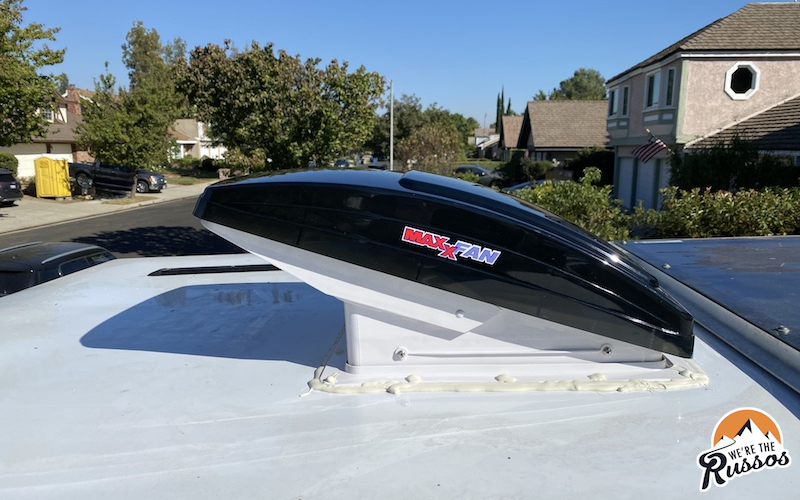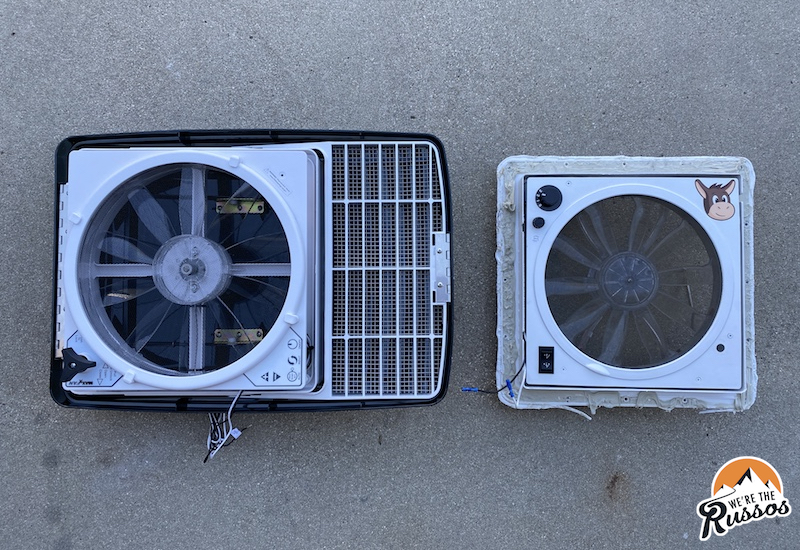This post may contain affiliate links.
Almost every new recreational vehicle comes with at least one RV roof vent fan. That should tell you how important an RV vent fan is and why you should consider the various brands and options before installing a new roof vent fan or swapping out your current RV vent fan for a different one. In this article, I’ll discuss the different RV vent fan options and what I consider to be the best RV vent fan and why.
Rather than keeping you in suspense, the best RV vent fan, in my opinion, is the MaxxAir MaxxFan Deluxe. Manufactured by RV components company Airxcel, the MaxxFan Deluxe line has several models including the MaxxFan 6200k that I installed on our pop-up truck camper. If you’re on a budget, I’ll also provide a fan that is under $60 (at the time of writing this).
Keep reading if you’re interested in why MaxxFan Deluxe is the best RV vent fan, other roof vent fan options and how to install an RV roof vent.
Note: the RV vent fans covered in this article fit a 14”x14” roof cutout. These are by far the most common camper vent fans. For smaller spaces there are smaller fans available and I will list some options at the end of this post.
Table of Contents
What is an RV Vent Fan?
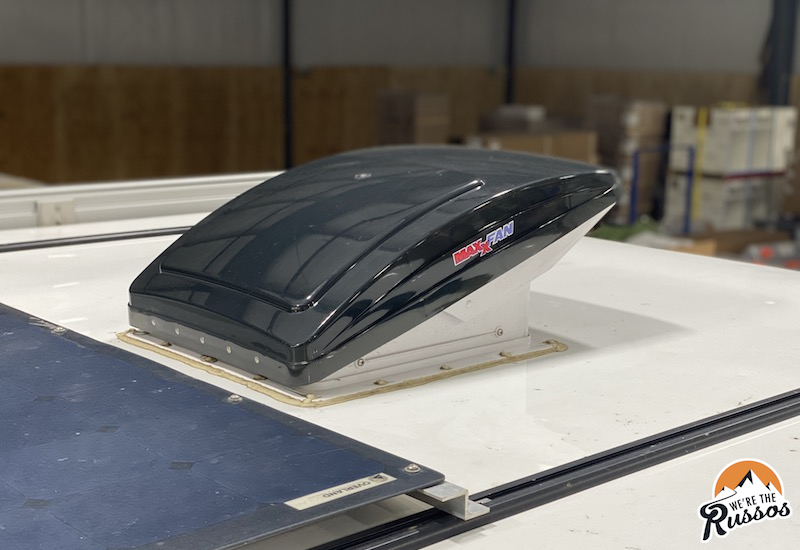
An RV vent fan is any fan in an RV that vents air outside. Typically, these fans are mounted on the roof of the RV, come with some type of cover that opens and closes and a screen to keep bugs and debris from coming into the camper. RV roof vent fans come in various sizes, but the most common is 14”x14”. Some of the smaller vent fans for sale may be installed on the side of the RV.
Do RV Vent Fans Work?
Absolutely! I’ve been RVing for 9 years now and I am always surprised at how much air a vent fan can move and what a difference they can make in cooling down a camper or getting rid of smells and steam.
1. Replace the Air Inside Your RV
An RV vent fan will allow you to open the windows and get fresh air flowing through your RV. This will help prevent smells from lingering inside after making a meal or using the bathroom. They also help reduce/prevent condensation within your RV which in turn helps prevent mold and mildew.
Most fans can move so much air that they are able to replace all of the air in the RV within minutes.
2. Help Keep the RV Cool on Hot Days
Most RV air conditioning systems are loud and you don’t always have access to shore power to run them. We’ve found that on most hot days, if we put the shades up, we can run the vent fan and the RV will stay cooler than it is outside. When we have run the A/C in the past, we enjoyed being able to turn it off when the temperature dropped in the evening and turn the vent fans on to bring in cool, fresh air. This is an essential benefit when the air outside is stagnant and there isn’t a breeze to help move air through your RV.
3. Minimal Power Draw
Even with limited battery power while boondocking, we’ve been able to run our roof vent fans all night with minimal draw.
RV Vent Fan Features
Before we get into specific RV vent fans, let’s look at some of the different features available:
Remote Control
RV Vent fans with wireless remotes allow the user to control the roof fan from anywhere in the camper. This feature is handy for those who might be in bed and find that it’s getting a bit too cold or hot in the RV and want to adjust the fan without having to get out of bed. The remote control for the vent typically comes with a cradle that can be mounted to the wall.
Some camper vent fans come with wall controls which are wired directly to the vent fan. The controls are similar to the wireless versions except you cannot move them throughout the RV once they’ve been installed.
RV vent fans without a remote will have their controls mounted directly on the fan itself which means that in order to operate it, you need to be able to reach the controls. Depending on the ceiling height of the RV, some people may not be able to reach the manual controls without a step.
What happens if you lose the remote, it stops working or your pup decides it needed a new chew toy while you were gone? RV vent fans with the remote control feature will also have manual controls directly on the vent fan so users can still operate the fan without the remote. That said, depending on how tall your ceilings are, you may not be able to reach the controls unless you have a step stool.
Electric or Manual Open
Some RV vent fans have the ability to open/close with an electric motor. This feature is typically offered in conjunction with a remote or wall control and rain sensor. If the motor should fail or there is a power outage to the RV, you can still open/close the vent by using the built in manual crank. This type of fan may also be referred to as an automatic or electric RV vent fan.
The manual vent fan option simply has a crank to open and close the RV roof vent.
Rain Sensor
The rain sensor will automatically close the RV vent fan when it detects moisture. This feature is available on some vent fan models that have an electric motor. Depending on the model and make of the RV vent fan, some rain sensors can be turned off to prevent the fan from closing in very humid conditions, like when you’re taking a shower.
Rain Cover/Shield
A vent cover for the RV vent fan can help prevent rain from coming into the interior of the camper when the fan is open. The cover allows you to run the RV vent fan when it’s raining, which is very helpful if you want to cook or simply bring in fresh air during a rain storm. The RV vent cover can also help protect the fan if you want to leave it open during heavy winds or while driving.
The MaxxAir MaxxFan Deluxe RV vent fans come with an integrated rain shield while Dometic/Fan-Tastic and other brands sell separate RV vent covers that can be mounted above the fan. The add-on vent covers are a good option if your camper already has an RV vent fan and you don’t want to swap out the entire unit. The one downside with the add-on vent covers is they will increase the height of your RV while the RV vent fan with integrated cover will have a lower profile when the cover is closed.
Speed Control
Most RV roof vent fans have between 3 to 14 different speeds and some even have variable speed controls. With more speeds, you have more ability to fine tune the noise and amount of air the fan is producing. For example, the first speed on a three speed fan might be the equivalent of the third or fourth speed on a fan with more settings.
Thermostat
Some fans have a built in thermostat that will turn the fan on and off at different temperatures. Certain fans only have a single set temperature they will turn on at while others have the ability for the user to set a specific temperature.
Intake and Exhaust
Basic RV vent fans will only have the ability to exhaust air out of the camper. Others are able to intake air as well as exhaust. The intake feature is great for those who like to have air blowing on them or have dual fans and set one to intake and the other to exhaust to maximize airflow throughout the RV.
The MaxxAir MaxxFan Deluxe models also have the ability to run the RV vent fan while the lid is closed to help circulate the air in the RV. Fan-Tastic vent fans have a pressure switch that turns the fan off when the cover is closed.
RV Vent Hack – when cooking outside, if you leave your doors open, set the fan(s) to intake and it will keep any smells and smoke from coming inside the RV. This even works with our camper van when the sliding door is open!
Which Features Do I Need?
Here are my thoughts on the RV vent fan features based on several years of experiences living in different types of RVs.
One of our favorite features of any RV vent fan is a rain cover. We installed a Fan-Tastic’s vent cover over the kitchen vent fan in our Class A RV and it was one of the best upgrades we made and one of the main reasons we swapped out the Fantastic vent for a MaxxAir MaxxFan Deluxe 6200 with the built in cover on our truck camper.
While it’s convenient to have a remote to control the vent fan when lying in bed, we prefer to have a fan with fewer features. The more complicated the RV vent fan, the more there is to go wrong. Plus, we don’t have to worry about asking the question “where is the remote?”
We’ve found that rain sensors are more trouble than they’re worth. While they are great if you leave your RV vent open and a rain storm hits while you’re away, they also tend to close the fan any time there is significant humidity in the air…especially when taking a shower. We found ourselves turning the rain sensor off most of the time.
While the thermostat feature seems like a good idea, we’ve never used it. For us, it was easier to just turn the fan on and let it run, regardless of the temperature.
Our Experiences with RV Vent Fans
Our first RV, a Newmar Bay Star Class A motorhome, had two RV vent fans. Then we downsized to a Class B ProMaster van which had one vent fan. Our most recent RV is a 4×4 truck camper which we ordered with one RV roof vent fan and one roof vent without a fan. All of these campers came with Fan-Tastic roof fans and vents installed from the factory. As a side note, the Fan-Tastic vent brand started being sold under the Dometic brand in 2017. We’ve had experience with different Dometic/Fan-Tastic models from one of their highest end models that had a rain sensor and remote to open and close the lid to the least expensive model that was just a manually operated vent with no fan. After all of our experience with Fan-Tastic vent fans, we’ve found them to be not so fantastic.
In our Class A, we had to replace the motor on both fans multiple times because after about a month of constant use, the bearing would go bad and the fans would squeak at lower speeds. We had the same problem with the fan in our Class B but chose to not change the motor since we didn’t have luck with doing so in the past. Most recently, the lid on our Fan-Tastic vent in the truck camper came free from the fan housing. After removing and inspecting it, I found that the rivets that held the lid in place were very thin and had worked loose, allowing the lid to come off. I was able to repair this myself by installing new rivets using a rivet gun. We also found that both of the vents in our truck camper would rattle quite a bit in the wind and wake us up in the middle of the night.
A friend of ours had replaced his Fan-Tastic vent fans with the MaxxFan Deluxe and when we got a chance to check it out, we found that not only was the vent fan significantly quieter than the Fan-Tastic fan we had, but it also seemed to be much better built and included a built-in rain cover.
We then made the decision to upgrade our Fan-Tastic/Dometic 1250 and vent with two MaxxAir MaxxFan Deluxe 6200ks. In the video below I share a review of the MaxxAir RV roof vents.
Pros of the MaxxFan Deluxe
It’s quiet. We’ve found the MAXXFAN Deluxe to be significantly quieter than the Fan-Tastic 1250 we replaced. Since the 1250 only has three speeds, the fan was noisy at the lowest speed. The MAXXFAN, has 10 speeds and on the lowest speed, we cannot hear the fan running. When we had a Fan-Tastic fan with 14 speeds, we would have to run the fan at higher speeds due to the squeak the fan would produce at the lowest setting.
Twin Lifting Arms. The twin lifting arms of the MAXXFAN offer more stability for the lid of the fan in winds and when driving. Even in high winds, we’ve found that there is little to no rattling of the lid. This is in contrast to the Fan-Tastic where even a stiff breeze would cause the lid to rattle quite loudly.
Built-in Rain Shield. The built-in rain shield on the MAXXFAN Deluxe retracts when the lid is lowered, keeping a much lower profile. This is handy because RVs are already fairly high and a low tree branch or overhang can easily rip off a fixed cover.
The Screen is Easy to Remove. The screen on the MAXXFAN has four tabs that twist out of the way and then the screen comes off for cleaning. On the Fan-Tastic fan, the screen is held in by clips and to remove the screen, you have to pull hard on the screen in order to free it and we’ve had one screen break doing this.
Customer Service. We had a part fail on our MAXXFAN and when we contacted customer service, they were helpful and sent out a new part very quickly. While we have had a number of problems with our Fan-Tastic fans, we’ve also had good experience with their customer service.
Cons of the MaxxFan Deluxe
Board Failure. The circuit board on our MAXXFAN stopped working after we had condensation build up in our RV. The condensation had pooled a bit on top of the circuit board and when we turned the fan on, it shorted and ceased to function. While customer service was helpful and this was something I was able to replace myself with a screwdriver and wire strippers, I found in my research that the circuit boards aren’t conformally coated – a coating which is applied to circuit boards to protect them from moisture and dust.
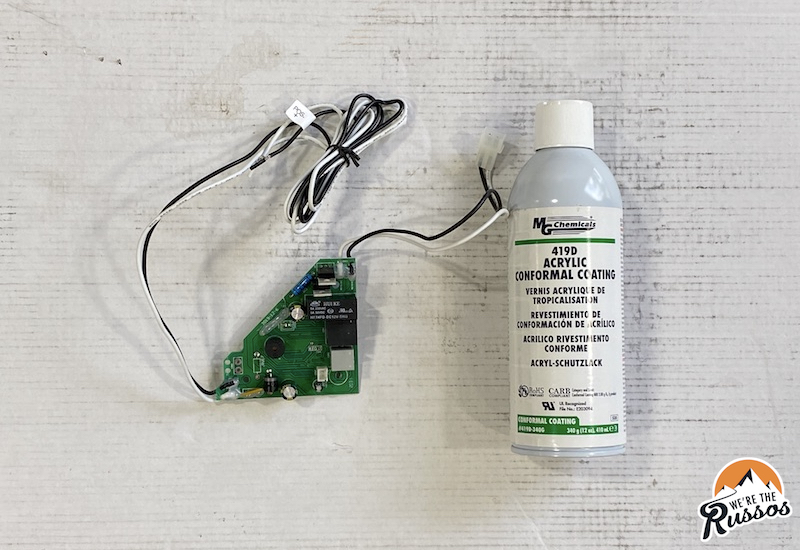
In order to rectify this issue, I purchased a can of conformal coating. When I received the new board, I covered the plugs with painter’s tape and sprayed it with the coating before I install it. I also removed the board from our second fan and sprayed it as well (this was brand new and not yet installed).
While I don’t know if Fan-Tastic vent fan board’s are coated, we never had an issue with them due to condensation.
Price. While the MaxxFan Deluxe vent fan models are more expensive than similar Fan-Tastic vent fans, when you factor in the cost of a vent fan cover for a Fan-Tastic vent fan, the cost comes out to be about the same. Check price of a MaxxFan Deluxe on Amazon.
Budget Fan Under $60
If you’re looking for something basic that won’t break the bank, this simple RV vent fan might be the answer. It has a simple crank for the lid and an on/off button with only a single speed and direction. While the fan itself is small, it can move a surprising amount of air.
Can I upgrade or replace my current RV Roof Vent Fan?
Yes you can! Swapping a Fan-Tastic vent for Maxxair is fairly straight forward and can be be a DIY project or done by a RV service technician. Most RV roof vent fans require a 14”x14” cut out in the roof and 12v power (positive and negative wires). If you are upgrading your current vent fan and it’s the same size as the new one, then the installation is fairly straight forward. Each vent fan is different so you’ll need to read and understand the instructions, follow all safety precautions and have the proper tools.
I would recommend the following items in order to upgrade your current RV vent fan. Again, check the manufacture instructions which will provide you with a list of items you’ll need to install it.
- Philips screw driver and appropriately sized socket wrench
- Putty knife
- Tape measure or ruler
- Multi-Meter (this is the Multi-Meter I have)
- Dicor self leveling lap sealant
- Butyl tape
- Caulk gun
- Wire cutters and wire strippers
- You may also need a small saw or other tool to trim the interior facia that comes with your new fan to fit your ceiling. When I installed our MaxxFans, I used a Dremel with a small cut-off wheel.
It took a couple of hours for each upgrade of our RV vent fan. The most time consuming part is removing all of the old sealant from the roof and prepping the surface for the new roof vent fan.
How to install a new RV roof vent fan?
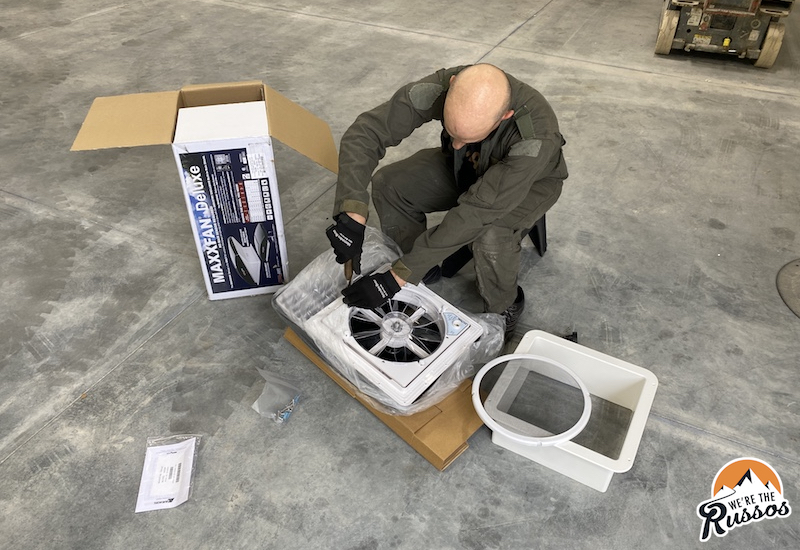
Installing a new RV roof vent fan where one was not installed before is not for the feint of heart as it involves cutting a hole in the roof and running 12v wiring to power the vent fan. My suggestion would be to have a professional tackle this project to make sure it’s done correctly and that the work is warranteed.
That said, you can save a bit of money if you just hire the professional to cut the holes and run the wires, then install the RV vent fan yourself.
Smaller RV Vent Fan Options
While the larger 14”x14” fans are standard in many RVs, not all campers have room for the larger fan, especially in the bathroom. There may also be limitations on where you can install a vent fan due to placement of other accessories on the roof.
These smaller RV vent fans are made for these tighter spaces, thin roofs and some can even be mounted in the sidewall of an RV.
MaxxFan Dome Vent
This small 12v 6” fan is able to be mounted on a 1-6” thick roof or sidewall. Perfect for ventilation and moisture control, this fan includes a locking lid, cover and screen.
Solar Roof Fan
If you don’t want to wire in a 12v fan, a small solar powered fan might be a good option. This fan by SOLATEK requires about a 5” cut out and the optional battery allows the fan to run 6-8 hours once the sun goes down.
Summary
A new or upgraded RV vent fan can dramatically improve the comfort inside your camper by circulating the air and keeping it cool inside. If you’re looking for the best RV vent fan for your camper, I hope this post was helpful to you.
What type of RV vent fan do you have in your camper? Does it have an integrated cover like MaxxFan 6200k?
